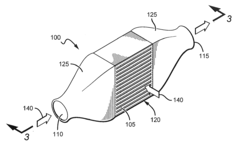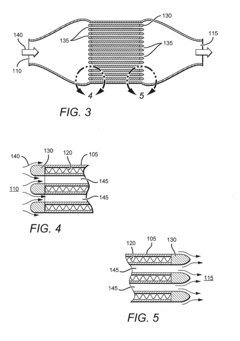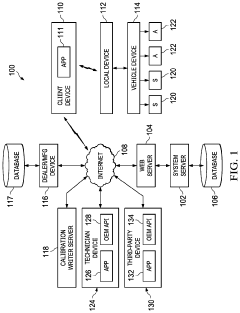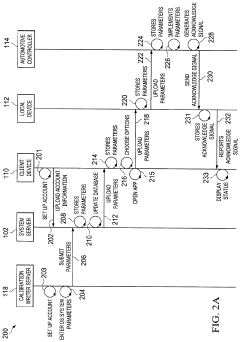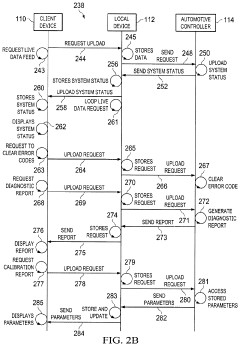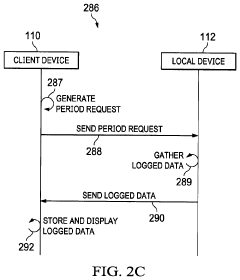K24 Engine Mods: Advances in Aftermarket Enhancements
JUL 3, 20259 MIN READ
Generate Your Research Report Instantly with AI Agent
Patsnap Eureka helps you evaluate technical feasibility & market potential.
K24 Engine Evolution
The K24 engine, a marvel of Honda's engineering prowess, has undergone significant evolution since its inception in 2001. Initially designed for the Honda Accord, this 2.4-liter inline-four engine quickly gained popularity for its robust performance and reliability. Over the years, Honda has continuously refined the K24, adapting it to meet changing emissions standards and performance demands.
The first generation K24A1 debuted with 160 horsepower and 161 lb-ft of torque. Subsequent iterations saw incremental improvements in power output and efficiency. The K24A2, introduced in 2003, featured i-VTEC technology, boosting performance while maintaining fuel economy. This innovation allowed for variable valve timing and lift on both intake and exhaust camshafts, a significant advancement in engine technology.
As emissions regulations tightened, Honda responded with the K24Z series. These engines incorporated improvements in fuel injection and combustion efficiency. The K24Z7, for instance, utilized a higher compression ratio and advanced variable valve timing to achieve better performance and reduced emissions. This evolution demonstrated Honda's commitment to balancing power with environmental responsibility.
The K24W, introduced in 2013, marked a significant leap forward. It featured direct injection technology, further improving fuel efficiency and power delivery. This iteration produced up to 206 horsepower in some applications, showcasing the engine's potential for high-performance applications while maintaining its reputation for reliability.
Throughout its evolution, the K24 has been adapted for use in various Honda and Acura models, from sedans to SUVs. Its versatility has been a key factor in its longevity, allowing it to meet diverse performance requirements across different vehicle platforms. This adaptability has also made it a favorite among aftermarket tuners and enthusiasts.
The engine's design has proven to be remarkably robust, capable of handling significant power increases with aftermarket modifications. This has led to a thriving aftermarket industry, with numerous companies developing performance parts specifically for the K24. From high-flow intake systems to forged internals, the availability of aftermarket components has allowed enthusiasts to push the K24 well beyond its stock capabilities.
In recent years, the focus of K24 development has shifted towards hybridization. Honda has integrated the K24 into its hybrid powertrains, demonstrating the engine's continued relevance in an increasingly electrified automotive landscape. This adaptation showcases the K24's enduring legacy and Honda's ability to evolve the platform to meet future challenges in automotive engineering.
The first generation K24A1 debuted with 160 horsepower and 161 lb-ft of torque. Subsequent iterations saw incremental improvements in power output and efficiency. The K24A2, introduced in 2003, featured i-VTEC technology, boosting performance while maintaining fuel economy. This innovation allowed for variable valve timing and lift on both intake and exhaust camshafts, a significant advancement in engine technology.
As emissions regulations tightened, Honda responded with the K24Z series. These engines incorporated improvements in fuel injection and combustion efficiency. The K24Z7, for instance, utilized a higher compression ratio and advanced variable valve timing to achieve better performance and reduced emissions. This evolution demonstrated Honda's commitment to balancing power with environmental responsibility.
The K24W, introduced in 2013, marked a significant leap forward. It featured direct injection technology, further improving fuel efficiency and power delivery. This iteration produced up to 206 horsepower in some applications, showcasing the engine's potential for high-performance applications while maintaining its reputation for reliability.
Throughout its evolution, the K24 has been adapted for use in various Honda and Acura models, from sedans to SUVs. Its versatility has been a key factor in its longevity, allowing it to meet diverse performance requirements across different vehicle platforms. This adaptability has also made it a favorite among aftermarket tuners and enthusiasts.
The engine's design has proven to be remarkably robust, capable of handling significant power increases with aftermarket modifications. This has led to a thriving aftermarket industry, with numerous companies developing performance parts specifically for the K24. From high-flow intake systems to forged internals, the availability of aftermarket components has allowed enthusiasts to push the K24 well beyond its stock capabilities.
In recent years, the focus of K24 development has shifted towards hybridization. Honda has integrated the K24 into its hybrid powertrains, demonstrating the engine's continued relevance in an increasingly electrified automotive landscape. This adaptation showcases the K24's enduring legacy and Honda's ability to evolve the platform to meet future challenges in automotive engineering.
Aftermarket Demand
The aftermarket demand for K24 engine modifications has seen significant growth in recent years, driven by enthusiasts seeking to enhance the performance and capabilities of their Honda and Acura vehicles. This demand stems from the K24's reputation as a robust and versatile engine platform, capable of substantial power increases with the right modifications.
Performance-oriented consumers are particularly interested in upgrades that boost horsepower and torque. Popular modifications include high-flow intake systems, performance exhaust headers, and engine management systems that allow for more aggressive tuning. These upgrades can typically yield power gains of 20-30 horsepower over stock configurations, satisfying the desire for improved acceleration and overall engine responsiveness.
Another segment of the aftermarket focuses on reliability enhancements for high-performance applications. This includes upgraded valve springs, forged pistons, and strengthened connecting rods, which allow the engine to withstand higher RPMs and increased boost pressure from forced induction setups. The demand for these components has grown as more enthusiasts push their K24 engines beyond factory specifications.
Forced induction kits, particularly turbocharger systems, represent a significant portion of the high-end aftermarket. These kits can dramatically increase engine output, often doubling the stock horsepower figures. The market for such systems has expanded as engineering advancements have made turbocharging more accessible and reliable for daily-driven vehicles.
The rise of motorsports featuring K24-powered vehicles has also fueled aftermarket demand. Time attack, drag racing, and endurance racing events have showcased the potential of modified K24 engines, inspiring street enthusiasts to emulate race-proven setups. This has led to increased sales of competition-grade components and complete engine builds.
Eco-conscious consumers have driven demand for modifications that improve fuel efficiency without sacrificing performance. This includes lightweight flywheels, underdrive pulleys, and advanced engine management systems that optimize fuel delivery and ignition timing. These upgrades appeal to daily drivers looking to balance performance gains with practical considerations.
The DIY culture within the Honda and Acura community has further stimulated aftermarket demand. Online forums, social media, and video platforms have facilitated knowledge sharing and showcased successful K24 builds, encouraging more enthusiasts to undertake engine modifications. This has led to a robust market for both complete kits and individual components, catering to various skill levels and budgets.
As the original K24-equipped vehicles age, there's a growing market for restoration and modernization parts. This includes OEM-quality replacement components as well as updated versions of stock parts that offer improved durability or performance. This trend ensures that the aftermarket continues to serve both performance enthusiasts and those looking to maintain and enhance their aging vehicles.
Performance-oriented consumers are particularly interested in upgrades that boost horsepower and torque. Popular modifications include high-flow intake systems, performance exhaust headers, and engine management systems that allow for more aggressive tuning. These upgrades can typically yield power gains of 20-30 horsepower over stock configurations, satisfying the desire for improved acceleration and overall engine responsiveness.
Another segment of the aftermarket focuses on reliability enhancements for high-performance applications. This includes upgraded valve springs, forged pistons, and strengthened connecting rods, which allow the engine to withstand higher RPMs and increased boost pressure from forced induction setups. The demand for these components has grown as more enthusiasts push their K24 engines beyond factory specifications.
Forced induction kits, particularly turbocharger systems, represent a significant portion of the high-end aftermarket. These kits can dramatically increase engine output, often doubling the stock horsepower figures. The market for such systems has expanded as engineering advancements have made turbocharging more accessible and reliable for daily-driven vehicles.
The rise of motorsports featuring K24-powered vehicles has also fueled aftermarket demand. Time attack, drag racing, and endurance racing events have showcased the potential of modified K24 engines, inspiring street enthusiasts to emulate race-proven setups. This has led to increased sales of competition-grade components and complete engine builds.
Eco-conscious consumers have driven demand for modifications that improve fuel efficiency without sacrificing performance. This includes lightweight flywheels, underdrive pulleys, and advanced engine management systems that optimize fuel delivery and ignition timing. These upgrades appeal to daily drivers looking to balance performance gains with practical considerations.
The DIY culture within the Honda and Acura community has further stimulated aftermarket demand. Online forums, social media, and video platforms have facilitated knowledge sharing and showcased successful K24 builds, encouraging more enthusiasts to undertake engine modifications. This has led to a robust market for both complete kits and individual components, catering to various skill levels and budgets.
As the original K24-equipped vehicles age, there's a growing market for restoration and modernization parts. This includes OEM-quality replacement components as well as updated versions of stock parts that offer improved durability or performance. This trend ensures that the aftermarket continues to serve both performance enthusiasts and those looking to maintain and enhance their aging vehicles.
Mod Challenges
Modifying the K24 engine presents several significant challenges that aftermarket enthusiasts and tuners must overcome. One of the primary obstacles is maintaining engine reliability while increasing performance. As power output is increased, internal components such as pistons, connecting rods, and bearings are subjected to higher stresses, potentially leading to premature wear or failure. Balancing performance gains with longevity requires careful consideration of material selection and engineering tolerances.
Another challenge lies in optimizing the engine management system to accommodate modifications. The stock ECU (Engine Control Unit) is calibrated for factory specifications, and significant modifications often necessitate reprogramming or replacement with an aftermarket unit. This process demands expertise in engine tuning to ensure proper fuel delivery, ignition timing, and overall engine efficiency across various operating conditions.
Heat management becomes increasingly critical as power output rises. The K24 engine's stock cooling system may struggle to dissipate the additional heat generated by performance modifications. Addressing this issue often requires upgrading the radiator, installing an oil cooler, or implementing more efficient intercooling systems for forced induction setups.
Emissions compliance presents a substantial hurdle, particularly in regions with strict environmental regulations. Many performance modifications can alter the engine's emissions profile, potentially rendering the vehicle non-compliant with local laws. Tuners must navigate the delicate balance between performance enhancement and maintaining legal emissions standards, often necessitating the use of high-flow catalytic converters or other emissions control strategies.
Integrating forced induction systems, such as turbochargers or superchargers, introduces complexities in terms of packaging and engine dynamics. The K24's naturally aspirated design requires careful consideration when adding these systems to ensure proper fitment within the engine bay and optimal airflow. Additionally, reinforcing the engine internals to withstand the increased pressure and managing boost levels to prevent detonation are crucial aspects of forced induction modifications.
Maintaining drivability and daily usability while pursuing performance gains is another significant challenge. Aggressive camshaft profiles or high-compression pistons that enhance peak power may compromise low-end torque and smooth operation, potentially affecting the vehicle's practicality for everyday use. Striking a balance between performance and drivability often requires extensive testing and fine-tuning.
Lastly, the financial aspect of K24 engine modifications cannot be overlooked. High-quality aftermarket parts and professional tuning services can be costly, and the pursuit of ever-increasing performance often leads to a cycle of continuous upgrades. Enthusiasts must carefully consider the cost-benefit ratio of each modification and prioritize their performance goals within budgetary constraints.
Another challenge lies in optimizing the engine management system to accommodate modifications. The stock ECU (Engine Control Unit) is calibrated for factory specifications, and significant modifications often necessitate reprogramming or replacement with an aftermarket unit. This process demands expertise in engine tuning to ensure proper fuel delivery, ignition timing, and overall engine efficiency across various operating conditions.
Heat management becomes increasingly critical as power output rises. The K24 engine's stock cooling system may struggle to dissipate the additional heat generated by performance modifications. Addressing this issue often requires upgrading the radiator, installing an oil cooler, or implementing more efficient intercooling systems for forced induction setups.
Emissions compliance presents a substantial hurdle, particularly in regions with strict environmental regulations. Many performance modifications can alter the engine's emissions profile, potentially rendering the vehicle non-compliant with local laws. Tuners must navigate the delicate balance between performance enhancement and maintaining legal emissions standards, often necessitating the use of high-flow catalytic converters or other emissions control strategies.
Integrating forced induction systems, such as turbochargers or superchargers, introduces complexities in terms of packaging and engine dynamics. The K24's naturally aspirated design requires careful consideration when adding these systems to ensure proper fitment within the engine bay and optimal airflow. Additionally, reinforcing the engine internals to withstand the increased pressure and managing boost levels to prevent detonation are crucial aspects of forced induction modifications.
Maintaining drivability and daily usability while pursuing performance gains is another significant challenge. Aggressive camshaft profiles or high-compression pistons that enhance peak power may compromise low-end torque and smooth operation, potentially affecting the vehicle's practicality for everyday use. Striking a balance between performance and drivability often requires extensive testing and fine-tuning.
Lastly, the financial aspect of K24 engine modifications cannot be overlooked. High-quality aftermarket parts and professional tuning services can be costly, and the pursuit of ever-increasing performance often leads to a cycle of continuous upgrades. Enthusiasts must carefully consider the cost-benefit ratio of each modification and prioritize their performance goals within budgetary constraints.
Popular K24 Mods
01 Engine control and optimization
Advanced control systems and algorithms are used to optimize the K24 engine's performance. These systems monitor various parameters such as fuel injection, ignition timing, and valve timing to enhance power output, fuel efficiency, and emissions control. Real-time adjustments are made based on driving conditions and engine load to ensure optimal performance across different scenarios.- Engine control and optimization: Advanced control systems and algorithms are used to optimize the K24 engine's performance. These systems monitor various parameters such as fuel injection, ignition timing, and valve timing to enhance power output, fuel efficiency, and emissions control. Real-time adjustments are made based on driving conditions and engine load to ensure optimal performance across different scenarios.
- Turbocharging and forced induction: Turbocharging technology is applied to the K24 engine to increase power output and efficiency. This involves using exhaust gases to drive a turbine, which in turn compresses the intake air, allowing more air and fuel to be burned in each cylinder. Advanced turbocharger designs and control systems are implemented to minimize turbo lag and optimize boost pressure across the engine's operating range.
- Variable valve timing and lift: The K24 engine incorporates variable valve timing and lift systems to improve performance and efficiency. These systems allow for dynamic adjustment of valve opening and closing times, as well as the amount of valve lift, based on engine speed and load. This results in improved power output at high RPMs while maintaining good low-end torque and fuel efficiency.
- Fuel injection and combustion optimization: Advanced fuel injection systems and combustion chamber designs are utilized to enhance the K24 engine's performance. Direct injection technology, coupled with precise fuel metering and spray patterns, improves fuel atomization and mixture formation. This leads to more efficient combustion, increased power output, and reduced emissions across the engine's operating range.
- Engine diagnostics and performance monitoring: Sophisticated diagnostic and monitoring systems are integrated into the K24 engine to ensure optimal performance and early detection of potential issues. These systems use various sensors and data analysis techniques to monitor engine parameters in real-time, allowing for predictive maintenance and performance optimization. Advanced onboard diagnostics help in identifying and addressing performance-related issues promptly.
02 Turbocharging and forced induction
Turbocharging technology is applied to the K24 engine to increase its power output and efficiency. This involves using exhaust gases to drive a turbine, which in turn compresses the intake air, allowing more air and fuel to be burned in each cylinder. The result is improved engine performance, particularly in terms of low-end torque and overall power delivery.Expand Specific Solutions03 Variable valve timing and lift
The K24 engine incorporates variable valve timing and lift systems to optimize performance across different engine speeds and loads. These systems allow for precise control of valve opening and closing times, as well as the amount of valve lift, resulting in improved power output, fuel efficiency, and emissions control throughout the engine's operating range.Expand Specific Solutions04 Fuel injection and combustion optimization
Advanced fuel injection systems and combustion chamber designs are employed to enhance the K24 engine's performance. Direct injection technology, coupled with optimized injector placement and spray patterns, ensures more efficient fuel atomization and combustion. This leads to improved power output, fuel economy, and reduced emissions.Expand Specific Solutions05 Engine diagnostics and performance monitoring
Sophisticated diagnostic and monitoring systems are integrated into the K24 engine to ensure optimal performance and early detection of potential issues. These systems use various sensors and data analysis techniques to monitor engine parameters in real-time, allowing for proactive maintenance and performance optimization. This helps maintain the engine's efficiency and longevity over time.Expand Specific Solutions
Key Aftermarket Brands
The K24 engine modification market is in a mature stage, with a diverse range of established players competing in a global market worth billions. The technology has evolved significantly since its introduction, with companies like K&N Engineering, EZ Lynk SEZC, and Powerteq LLC leading innovations in aftermarket enhancements. These firms offer advanced solutions for improving engine performance, fuel efficiency, and emissions control. The market is characterized by a mix of large automotive manufacturers such as GM, Toyota, and Honda, alongside specialized aftermarket parts suppliers. This competitive landscape drives continuous innovation in engine modification technologies, catering to both performance enthusiasts and eco-conscious consumers.
K&N Engineering, Inc.
Technical Solution: K&N Engineering has developed advanced air intake systems specifically designed for the K24 engine. Their cold air intake system increases airflow by up to 50% compared to stock intakes[1], utilizing a high-flow cotton air filter that provides excellent filtration while allowing for increased air volume. The system also incorporates a heat shield to isolate the filter from engine bay heat, ensuring cooler air enters the engine. K&N's intake design has been optimized through extensive dyno testing and real-world driving to deliver consistent performance gains across the RPM range[2]. Additionally, they offer reusable oil-based air filters that can be cleaned and re-oiled, providing long-term cost savings and environmental benefits.
Strengths: Significant airflow improvement, reusable filter design, and proven performance gains. Weaknesses: Higher initial cost compared to stock components and potential for over-oiling if not maintained properly.
EZ Lynk SEZC
Technical Solution: EZ Lynk has developed a unique cloud-based tuning platform that can be applied to K24 engine modifications. Their Auto Agent system allows for remote tuning and real-time monitoring of engine parameters via a smartphone app[11]. For K24 applications, EZ Lynk offers custom tuning solutions that can optimize engine performance based on specific modifications and driving conditions. Their platform supports advanced features such as adjustable launch control, custom shift points for automatic transmissions, and the ability to switch between multiple tunes on-the-fly. EZ Lynk's system also incorporates machine learning algorithms that can analyze driving patterns and environmental conditions to suggest optimal tune adjustments, potentially improving both performance and fuel efficiency by up to 7% compared to static tunes[12].
Strengths: Cloud-based platform allows for easy updates and remote tuning, advanced features like real-time adjustments. Weaknesses: Requires constant internet connectivity for full functionality, and potential privacy concerns with cloud-based data storage.
Innovative Mod Tech
Intercooler system
PatentInactiveUS20120291993A1
Innovation
- The use of unique coil configurations and profiled passage separators to enhance airflow through the intercooler, applying basic fluid mechanics to improve fluid flow and temperature cooling in a smaller packaging size, with convex surfaces funneling fluid efficiently through passageways.
System and method for remote ECU reprogramming
PatentActiveUS20200174780A1
Innovation
- A cloud-based system utilizing a J2534 compliant hardware device with a SAE J1962 OBDII connector, connected via Wi-Fi or Bluetooth, allows for universal communication with ECUs using standardized protocols like ISO9141, ISO14230, CAN, and others, enabling remote diagnostics and software updates through a client device.
Emissions Regulations
Emissions regulations play a crucial role in shaping the landscape of aftermarket enhancements for the K24 engine. As environmental concerns continue to grow, governments worldwide have implemented increasingly stringent emissions standards, directly impacting the development and adoption of engine modifications.
In the United States, the Environmental Protection Agency (EPA) and the California Air Resources Board (CARB) set the benchmark for emissions regulations. These agencies have established strict limits on pollutants such as carbon monoxide, nitrogen oxides, and particulate matter. Aftermarket manufacturers must ensure that their K24 engine modifications comply with these standards to remain legal for on-road use.
The challenge for aftermarket companies lies in balancing performance enhancements with emissions compliance. Many traditional modifications, such as high-flow air intakes and performance exhaust systems, can potentially increase emissions. As a result, manufacturers have had to innovate and develop new technologies to maintain performance gains while meeting regulatory requirements.
One significant advancement in this area is the development of catalytic converters specifically designed for modified K24 engines. These high-flow catalytic converters offer improved exhaust gas conversion efficiency without significantly restricting exhaust flow, allowing for both increased performance and emissions compliance.
Another area of innovation is in engine management systems. Advanced ECU tuning techniques now allow for precise control over fuel injection and ignition timing, optimizing both performance and emissions across a wide range of operating conditions. Some aftermarket companies have even developed complete plug-and-play engine management systems that are pre-programmed to maintain emissions compliance while delivering improved performance.
The impact of emissions regulations extends beyond individual components to entire aftermarket packages. Many companies now offer CARB-certified performance kits for the K24 engine, ensuring that customers can enhance their vehicles without running afoul of local laws. These kits typically include a combination of hardware upgrades and software tuning, all designed to work together within the bounds of emissions regulations.
Looking forward, the trend towards stricter emissions standards is likely to continue, presenting both challenges and opportunities for the aftermarket industry. As regulations evolve, we can expect to see further innovations in areas such as materials science, combustion efficiency, and exhaust after-treatment technologies. The ability to adapt to these changing regulations will be a key factor in the success of aftermarket companies operating in the K24 engine modification space.
In the United States, the Environmental Protection Agency (EPA) and the California Air Resources Board (CARB) set the benchmark for emissions regulations. These agencies have established strict limits on pollutants such as carbon monoxide, nitrogen oxides, and particulate matter. Aftermarket manufacturers must ensure that their K24 engine modifications comply with these standards to remain legal for on-road use.
The challenge for aftermarket companies lies in balancing performance enhancements with emissions compliance. Many traditional modifications, such as high-flow air intakes and performance exhaust systems, can potentially increase emissions. As a result, manufacturers have had to innovate and develop new technologies to maintain performance gains while meeting regulatory requirements.
One significant advancement in this area is the development of catalytic converters specifically designed for modified K24 engines. These high-flow catalytic converters offer improved exhaust gas conversion efficiency without significantly restricting exhaust flow, allowing for both increased performance and emissions compliance.
Another area of innovation is in engine management systems. Advanced ECU tuning techniques now allow for precise control over fuel injection and ignition timing, optimizing both performance and emissions across a wide range of operating conditions. Some aftermarket companies have even developed complete plug-and-play engine management systems that are pre-programmed to maintain emissions compliance while delivering improved performance.
The impact of emissions regulations extends beyond individual components to entire aftermarket packages. Many companies now offer CARB-certified performance kits for the K24 engine, ensuring that customers can enhance their vehicles without running afoul of local laws. These kits typically include a combination of hardware upgrades and software tuning, all designed to work together within the bounds of emissions regulations.
Looking forward, the trend towards stricter emissions standards is likely to continue, presenting both challenges and opportunities for the aftermarket industry. As regulations evolve, we can expect to see further innovations in areas such as materials science, combustion efficiency, and exhaust after-treatment technologies. The ability to adapt to these changing regulations will be a key factor in the success of aftermarket companies operating in the K24 engine modification space.
Dyno Testing Methods
Dyno testing methods play a crucial role in evaluating the performance gains achieved through K24 engine modifications. These methods provide quantifiable data on horsepower, torque, and overall engine efficiency, allowing enthusiasts and professionals to assess the effectiveness of aftermarket enhancements accurately.
The most common dyno testing method for K24 engine mods is the chassis dynamometer, which measures power output at the wheels. This approach accounts for drivetrain losses and provides a realistic representation of the engine's performance in real-world conditions. Inertia dynos and load-bearing dynos are two primary types used for K24 testing, each with its own advantages.
Inertia dynos utilize a heavy roller to simulate vehicle mass and measure acceleration rates. This method is particularly useful for evaluating the K24 engine's power curve and identifying areas where modifications have improved performance. Load-bearing dynos, on the other hand, apply a controlled load to the engine, allowing for more precise measurements across different RPM ranges and load conditions.
To ensure accurate and repeatable results, proper dyno testing protocols must be followed. This includes allowing the K24 engine to reach optimal operating temperature, maintaining consistent ambient conditions, and performing multiple runs to account for variations. Standardized correction factors, such as SAE J1349 or DIN 70020, are applied to normalize results across different atmospheric conditions.
Advanced dyno testing methods for K24 engine mods often incorporate additional sensors and data logging equipment. These may include air/fuel ratio monitors, exhaust gas temperature sensors, and boost pressure gauges for turbocharged applications. This comprehensive data collection allows for a more detailed analysis of the engine's performance and helps identify potential areas for further optimization.
Comparative dyno testing is essential when evaluating specific K24 engine modifications. This involves establishing a baseline measurement with the stock engine configuration, followed by subsequent tests after each modification. This step-by-step approach enables enthusiasts to quantify the performance gains attributed to individual components or tuning adjustments.
Modern dyno testing facilities often utilize software that can simulate various driving conditions, such as altitude changes or different weather scenarios. This capability is particularly valuable for K24 engine builds intended for specific racing applications or environments, allowing for fine-tuning of the engine's performance characteristics under diverse conditions.
As K24 engine mods continue to evolve, dyno testing methods are also advancing. Some facilities now offer mobile dyno services, bringing professional-grade testing equipment directly to workshops or race events. Additionally, virtual dyno simulations are gaining traction, allowing for preliminary performance predictions based on engine specifications and modifications before physical testing takes place.
The most common dyno testing method for K24 engine mods is the chassis dynamometer, which measures power output at the wheels. This approach accounts for drivetrain losses and provides a realistic representation of the engine's performance in real-world conditions. Inertia dynos and load-bearing dynos are two primary types used for K24 testing, each with its own advantages.
Inertia dynos utilize a heavy roller to simulate vehicle mass and measure acceleration rates. This method is particularly useful for evaluating the K24 engine's power curve and identifying areas where modifications have improved performance. Load-bearing dynos, on the other hand, apply a controlled load to the engine, allowing for more precise measurements across different RPM ranges and load conditions.
To ensure accurate and repeatable results, proper dyno testing protocols must be followed. This includes allowing the K24 engine to reach optimal operating temperature, maintaining consistent ambient conditions, and performing multiple runs to account for variations. Standardized correction factors, such as SAE J1349 or DIN 70020, are applied to normalize results across different atmospheric conditions.
Advanced dyno testing methods for K24 engine mods often incorporate additional sensors and data logging equipment. These may include air/fuel ratio monitors, exhaust gas temperature sensors, and boost pressure gauges for turbocharged applications. This comprehensive data collection allows for a more detailed analysis of the engine's performance and helps identify potential areas for further optimization.
Comparative dyno testing is essential when evaluating specific K24 engine modifications. This involves establishing a baseline measurement with the stock engine configuration, followed by subsequent tests after each modification. This step-by-step approach enables enthusiasts to quantify the performance gains attributed to individual components or tuning adjustments.
Modern dyno testing facilities often utilize software that can simulate various driving conditions, such as altitude changes or different weather scenarios. This capability is particularly valuable for K24 engine builds intended for specific racing applications or environments, allowing for fine-tuning of the engine's performance characteristics under diverse conditions.
As K24 engine mods continue to evolve, dyno testing methods are also advancing. Some facilities now offer mobile dyno services, bringing professional-grade testing equipment directly to workshops or race events. Additionally, virtual dyno simulations are gaining traction, allowing for preliminary performance predictions based on engine specifications and modifications before physical testing takes place.
Unlock deeper insights with Patsnap Eureka Quick Research — get a full tech report to explore trends and direct your research. Try now!
Generate Your Research Report Instantly with AI Agent
Supercharge your innovation with Patsnap Eureka AI Agent Platform!
